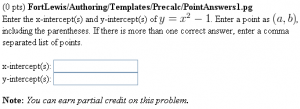PointAnswers1
Answer is a Point or a List of Points
This PG code shows how to evaluate answers that are points or lists of points.
- Download file: File:PointAnswers1.txt (change the file extension from txt to pg when you save it)
- File location in NPL:
FortLewis/Authoring/Templates/Precalc/PointAnswers1.pg
| PG problem file | Explanation |
|---|---|
|
Problem tagging: |
|
DOCUMENT(); loadMacros( "PGstandard.pl", "MathObjects.pl", "AnswerFormatHelp.pl", "contextLimitedPoint.pl", ); TEXT(beginproblem()); |
Initialization:
We only need to load |
Context("LimitedPoint");
$f = Compute("x^2-1");
$xint = List( Point("(1,0)"), Point("(-1,0)") );
$yint = List( Point("(0,-1)") );
|
Setup:
We could have used |
Context()->texStrings;
BEGIN_TEXT
Enter the x-intercept(s) and y-intercept(s)
of \( y = $f \). Enter a point as \( (a,b) \),
including the parentheses. If there is more
than one correct answer, enter a comma
separated list of points.
$BR
$BR
x-intercept(s): \{ ans_rule(20) \}
\{ AnswerFormatHelp("points") \}
$BR
y-intercept(s): \{ ans_rule(20) \}
\{ AnswerFormatHelp("points") \}
END_TEXT
Context()->normalStrings;
|
Main Text: Be sure to tell students the proper syntax for how to enter their answers. |
$showPartialCorrectAnswers = 1; ANS( $xint->cmp() ); ANS( $yint->cmp() ); |
Answer Evaluation: |
Context()->texStrings;
BEGIN_SOLUTION
${PAR}SOLUTION:${PAR}
Solution explanation goes here.
END_SOLUTION
Context()->normalStrings;
COMMENT('MathObject version.');
ENDDOCUMENT();
|
Solution: |
